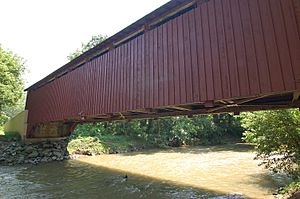Baumgardener's Covered Bridge facts for kids
Quick facts for kids Baumgardener's Covered Bridge |
|
|---|---|
 |
|
| Coordinates | 39°55′50″N 76°17′42″W / 39.93056°N 76.29500°W |
| Carries | Township 427 |
| Crosses | Pequea Creek |
| Official name | Pequea #10 Bridge |
| Maintained by | Lancaster County |
| WGCB Number | 38-36-25 |
| Characteristics | |
| Design | Burr Arch Truss Bridge |
| Total length | 120 ft (37 m) |
| Width | 4.3 m (14 ft) |
| Height | 11.5 ft (3.5 m) |
| History | |
| Constructed by | Davis Kitch |
| Construction end | 1860 |
|
Baumgardner's Mill Covered Bridge
|
|
| MPS | Covered Bridges of Lancaster County TR |
| NRHP reference No. | 80003541 |
| Added to NRHP | December 11, 1980 |
The Baumgardener's Covered Bridge is a special kind of bridge. It is a covered bridge, which means it has a roof and sides, like a tunnel. This bridge crosses the Pequea Creek in Lancaster County, Pennsylvania, United States. The county owns and takes care of it. Its official name is the Pequea #10 Bridge. A mill was built nearby in 1800.
This bridge has a single span. It is made of wood and uses a special design called a Burr Arch Truss. This design uses strong wooden arches to help support the bridge. It also has extra steel rods for strength. The floor of the bridge is made from strong oak planks. The bridge is painted red, which is a common color for covered bridges in Lancaster County. The parts leading up to the bridge are painted white.
You can find the bridge about 0.5 miles (0.80 km) north of Frogtown Road. It is on Covered Bridge Road, just east of Pennsylvania Route 324 in Martic Township. The bridge has a special number from the World Guide to Covered Bridges: 38-36-25. It was added to the National Register of Historic Places on December 11, 1980. This means it is an important historical site.
History of the Bridge
The Baumgardener's Covered Bridge was built a long time ago in 1860. A builder named Davis Kitch constructed it. The cost to build it was $1,284.
Restoring the Bridge
In 1987, the bridge needed a lot of work. It had been damaged by a flood the year before. During this restoration, the bridge was made taller by 4 feet (1.2 m). It was also made longer by 9 feet (2.7 m). This work cost $200,000. These changes help protect the bridge from future floods.
Images for kids
See Also




